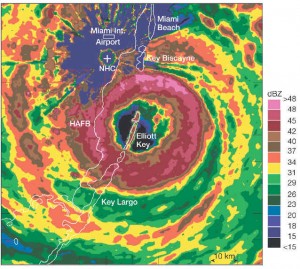Today is the 23rd anniversary of the landfall of Hurricane Andrew, one of the most devastating hurricanes ever to hit Florida. My husband and I visited his aunt in Miami almost a year after the storm, and the amount of damage that remained, some places looking virtually untouched, was sobering. It is also the 10th anniversary of Katrina’s first landfall in Florida before it went on to hit Louisiana and the Gulf Coast. You will hear many stories about this in the media this week.
On my Facebook feed today, Bryan Norcross, the Miami television meteorologist that helped many people safely ride out Andrew, posted a powerful essay about our preparedness (or lack thereof) for hurricanes in the future. Since so many of us in the Southeast are affected by these and other natural disasters, I am choosing to run his entire post here. I hope you find it as compelling as I do.
Imagine Andrew and Katrina
A number of big hurricane anniversaries are coming up, most notably the two defining storms of the modern era. Both hit the Miami area during this third week of August and went on to make landfall in Louisiana.
For people that went through Hurricane Andrew, this is the night that the world changed – August 23rd. It was about 8:00 PM that Sunday evening that the eye first came into radar view. By 10:00 PM is was clear that the core of the hurricane was going to hit Dade County, and the storm was getting stronger with every radar sweep. We said on TV that everyone should be in their final spot at midnight, and indeed the winds picked up to tropical-storm force right on schedule. This was it.
The radar picture became more detailed and more frightening as the storm drew closer. At about 1:00 AM it was clear to me that action was required beyond any “normal” hurricane preparation. The question was, where in a Florida house would be the safest possible spot? In a closet or a bathtub under a mattress was the answer. And thankfully, for most people it worked. I still run into Andrew survivors who rode out the storm with their family and pets under a mattress, and when they finally crawled out they saw an unrecognizable world that a very few hours before was their neighborhood.
It was early Monday morning, August 24, 1992.
Thirteen years and one day later, Hurricane Katrina came ashore on the Miami-Dade/Broward line, and went on to be the deadliest and most expensive natural disaster in modern times when it devastated the Mississippi coast and crushed the deficient flood walls in and around New Orleans.
A lot will be said this week as we remember Katrina. And remember we should. But it’s important that we remember more than just the flooded neighborhoods and devastated coastline. After every great hurricane we talk about the lessons never to be forgotten. Then time passes and memories fade. The most important things to remember this week are the lessons that the storms taught us, and that, in fact, much of what happened was not a surprise.
We knew that Miami-area homes built in the 1980s – when northern building styles, construction shortcuts, and lax inspections became endemic – would not survive a powerful hurricane like South Florida had seen many times in the past.
The widespread destruction in New Orleans had been talked about for years. We knew it would happen if the flood walls failed, which was most likely in a large-diameter hurricane. And we knew people would die because they didn’t evacuate, and that not everybody would or could.
Looking ahead, we know that people these days are dependent on their mobile phones like never before. And we know that voice calls become impossible and bandwidth becomes restricted during every emergency. We also know most people no longer have transistor radios, most portable TVs are paperweights in the era of digital television, and America’s news organizations were tremendously weakened by the recession, never to fully recover. News-consumption trends and media corporatization have only made it worse. We know our ability to communicate during and after a major hurricane is dramatically diminished.
Many aspects of the emergency-response system have been strengthened in the years since Katrina. Evacuation planning and FEMA coordination are dramatically improved. But in states and cities throughout the hurricane zone, new residents, emergency managers, and news people have no hurricane experience. Unless you’ve seen it and felt it, it’s hard or impossible to imagine, and therefore hard to plan for. And limited resources in government and media make proper planning harder than ever.
So let’s do more than remember this week. Let’s also try to imagine. Imagine what your hurricane experience will be with no cell service and/or a dead cell phone. How will the media report from remote locations if reporters can’t contact home base? Imagine what it will be like stuck in your high rise with no power, no water, and no elevators. Imagine your car buried in sand or inundated with floodwater because you left it on the street or in the parking garage under your building. Imagine being stranded with no transportation and no ability to call for help along with everyone else who did not have a plan.
Preparation starts with imagination. Could there be a better week to start imagining?
